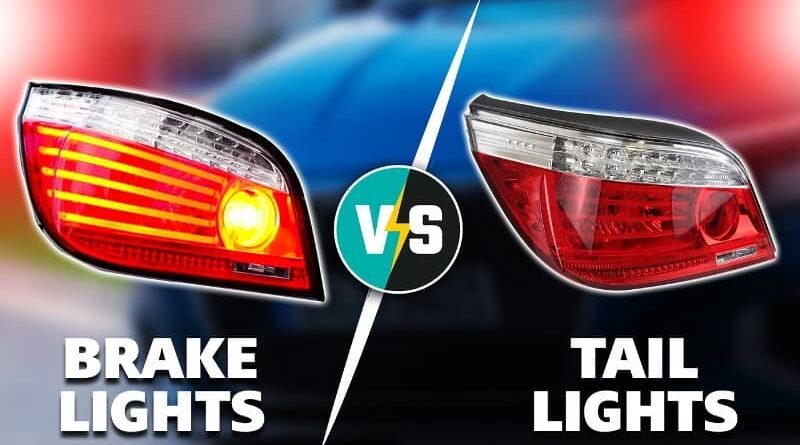
Have you ever mused about the dissimilarities between your brake lights and tail lights? You ought to be aware of significant differences from a safety and legal standpoint despite both being used for lighting up the rear end of your car.
Although it may be given little thought by several drivers, comprehending the contrast between a tail light vs brake light is fundamental for upholding your security on the road.
They not only perform many activities, but their use is governed by law, and utilizing them improperly may have legal repercussions.
Understanding how these lights function will help you drive safely and legally at all times.
.
To know about their functioning in detail, watch this video. Plus, below, there is a list of differences you need to know about them.
Understanding What Tail Lights
2.1 Function
Tail lights are frequently equipped on the rear of a car, and they’re primarily responsible for informing fellow drivers about their car’s whereabouts while on the road.
When headlights and taillights illuminate the road at night, red taillight signals allow other drivers to determine the vehicle’s positioning and sizing.
2.2 Types
Tail lights are available in various designs, such as halogen lamps, retro incandescent bulbs, and advanced L.E.D. lights.
The longevity, energy economy, and greater illumination of L.E.D. tail lights have increased their appeal.
2.3 Importance
Tail lights are essential for drivers’ and other drivers’ safety. They warn oncoming cars, lowering the possibility of rear-end collisions and assisting in maintaining a safe distance.
They also improve the vehicle’s visibility in bad weather like fog, rain, or snowstorms.
3. Understanding Brake Lights
3.1 Function
Brake lights notify other drivers when a driver uses the brakes, as their name suggests. When the brake pedal is depressed, they are activated, alerting other vehicles that the vehicle is slowing down or stopping. Brake lights are frequently brighter and more colorful than tail lights, attracting drivers’ attention behind the car.
3.2 Types
Compared to tail lights, brake lights can be powered by L.E.D., halogen, or incandescent bulbs. With their quick response time and increased brightness, L.E.D. brake lights are gaining popularity as they are quite noticeable to other vehicles.
3.3 Importance
Brake lights are critical for communicating the driver’s intentions to vehicles behind. They provide essential information to other drivers, indicating when a vehicle is slowing down or stopping. By promptly alerting other drivers, brake lights prevent rear-end collisions and improve overall road safety.
4. Differences Between Brake Lights vs Tail Lights
4.1 Purpose
While brake lights signal when the car is slowing down or stopping, tail lights primarily work as position markers and improve vehicle vision on the road.
4.2 Placement
Brake lights are often placed on either side of the taillights, whereas tail lights are placed towards the back of the car. Brake lights may be built inside the housing of the taillights in some vehicles.
4.3 Illumination
Red taillights appear to be continuously lit when the headlamps turn on, and as soon as you step on your car’s brake pedal, the intensity of the rear lights increases instantly.
4.4 Activation
You must depress the foot pedal to activate the brake lights, while taillights are always operational when headlights are turned on.
5. Legal Requirements
Regulations regarding tail lights and brake lights vary between jurisdictions. Understanding the legal requirements to ensure compliance and promote road safety is essential.
5.1 Tail Light Regulations
Regulations governing tail light intensity, color, and placement may vary by area. To improve visibility, some jurisdictions could mandate the application of reflective materials on the back of cars.
5.2 Brake Light Regulations
Brake lights are subject to regulations regarding their brightness, response time, and visibility. These regulations ensure that brake lights effectively communicate a driver’s braking actions to other vehicles.
6. Maintenance and Replacement
6.1 Tail Light Maintenance
Regularly inspect the condition of tail lights, ensuring they are clean, undamaged, and free from moisture. Replace any broken or malfunctioning bulbs promptly.
6.2 Brake Light Maintenance
Check brake lights regularly to ensure they are functioning correctly. If you notice any flickering, dimness, or irregularities in brightness, have the lights inspected and replaced if necessary.
6.3 Tail Light Replacement
Select the correct bulb or L.E.D. assembly for your vehicle model when replacing tail lights. Follow the manufacturer’s instructions or seek professional assistance if needed.
6.4 Brake Light Replacement
Similarly, when replacing brake lights, choose the appropriate bulbs or L.E.D. assemblies suitable for your vehicle. Adhere to the manufacturer’s guidelines or consult a professional for required assistance.
Conclusion
In conclusion, tail lights and brake lights serve distinct yet vital roles in vehicle lighting systems. While brake lights signal a driver’s intention to brake or slow down, tail lights improve the visibility and location of a vehicle.
For road safety and optimum vehicle performance, it is essential to comprehend the distinctions between these lights, follow the law, and execute routine maintenance.
F.A.Q.s
-
Can I use my tail lights as brake lights?
No, tail lights and brake lights have different functions. Tail lights are not designed to emit intense brightness to indicate braking actions.
Brake lights are specifically built to fulfill this purpose.
2. How often should I check my tail lights and brake lights?
Regular inspections of tail lights and brake lights are recommended. A monthly check is a good practice to ensure they are functioning correctly. Additionally, inspect them before long journeys or during routine vehicle maintenance.
3. Can I upgrade my tail lights or brake lights to L.E.D.?
Yes, upgrading traditional incandescent or halogen tail and brake lights to L.E.D. is possible. L.E.D. lights offer several advantages, such as energy efficiency, longevity, and improved brightness.
However, ensure that the L.E.D. lights you choose to comply with legal regulations.
4. Are there any alternative lighting options for vehicles?
Apart from traditional tail lights and brake lights, other lighting options are available for vehicles.
This includes auxiliary lighting, such as fog lights, daytime running lights (DRLs), and accent lights, which can enhance visibility and aesthetics. Check your local regulations regarding the use of additional lighting.


